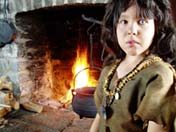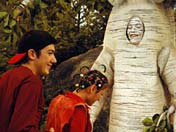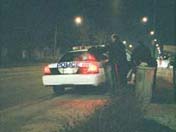

|
 |
|||
| roads by the thousands - Jorge Sanjines retrospective - the festival in Kahnawake - search engine | |||
| NFB THEATRE > JUNE 13 TO 22
Navigable canals, living water, unsuspected itineraries, as new landscapes emerge on unmarked detour roads: as pilgrims to secret places, First Nations filmmakers have embarked with the passion of tireless travellers on a creative and systematic exploration of the imaginary and real terrains of Amerindian space. In their footsteps, 2005 festivalgoers can plot out different types of itineraries to make their way among these many paths. Here are a few storylines spun out as possible guides to get ones bearings in the maze of new productions that First Nations film and video makers have brought for us to see. |
|||
| ROYAL ROAD TO RECOGNITION One could opt for the royal road, the paths paved by recognition, and opt for films that have won awards, nominations or simply have been chosen by prestigious festivals. Here are some of these choice options: Stryker, Venice 2004 selection, follows the steps of a young recruit in the Indian Posse group in a gritty part of Winnipeg. He will spark off a gang war and find himself in its midst. Basal Banar was a selection at Yamagata, the "Documentary Olympics" in 2003. It is a shamanic introduction to the sacred rituals of the Palaw'an nation in the Philippines. Best foreign short subject nomination at the 2005 Oscars and a Montreal premier, Two Cars One Night has come from New-Zealand. Dhakiyaar vs the King, a film about the need for reconciliation won the Ruben Mamoulian award at the Sydney Film Festival and was chosen as best 2004 documentary in its home country, Australia. We will come back to the folks who made Hot Docs (Reservation, The Tunguska Project) and the Yolande and Pierre Perrault award (One More River) (1) for the best Quebec documentary hope. Please not that formal wear is not required during screenings. CLOSE TO HOME People who want to explore their own backyard and discover Quebec First Nations can also get their fill at First Peoples' Festival 2005. At the starting line, productions from this part of the Aboriginal world, launches and premiers. Film and TV artisans will be on hand to present their latest creations. An outing in our own corner of the world: Among the Wemotaci Atikamekw: Awin Ni Nin is a clip mobilising all the community's voices in a choral expression of the Amerindian world. This was one of the videos produced in the Wapikoni Mobile project, a travelling production unit enabling youth in isolated communities to tell their own stories. In Kahnawake: Mohawk Girls follows four teenaged students, their childhood behind them and their future looming up close. A production from Rezolution Pictures, a Cree company that is making a name for itself as a major producer among Quebec First Nations, both in terms of the number and quality of its products. In Innu and Mohawk lands: from Tshinanu, a series produced by ECP productions, a long-term partner of our festival, Vieillir by Joséphine Bacon and Se surpasser by Jason Brennan deal respectively with old age at Uashat and a young Olympic hope at Mashteuiatsh. As part of the series, Décider by Magnus Isacsson allows us to witness the controversy about building a casino in Kahnawake, as seen from within the community. Time travel: ECP productions also brings us Le Rouge et le Noir... au service du Blanc (Esclavage en Nouvelle-France) by Marquise Lepage, the closing film. This is a journey back in time to visit Canada during the French regime to discover one of its little-known facets: slavery. In the land of legends: Mikuan et Tshako, from the K8e K8e production company is a new children's series filmed simultaneously in Innu and in French. With Marco Bacon, whose many admirers impatiently await his return on the big screen. FASTEN YOUR SEATBELTS! But viewers who would rather experience adventures on new trails where the landscape takes on unexpected forms, or danger and wonder at every turn on little-travelled roads, can find their share of off-road circuits. Return to Monument Valley and the surrounding canyons in the feature film Fifth World, in the company of young Navajos who know every nook and cranny of the mythical surroundings that they encounter in their journey. Thrilling. Come along on a Siberian trek alongside multidisciplinary author and artist Floyd Favel. More specifically, it is a visit to the Evenki people. In 1908 their territory witnessed a strange explosion with a phenomenal force whose seismic wave was felt by the entire planet. The Tunguska Project is a documentary expressing creative anxiety, an uncomfortable journey, and a mysterious star, mythical and shamanic tales. Not your usual travel film. Follow Dana Claxton in an obsessive reiteration of the meaningful elements of a particular sequence — Gun Play and The Hill — or, a more peaceful amble along with Diane Kitchen in the deep woods Quick's Thicket. Postmodern routes. Plunge in with Shirley Cheecho. In the Andes to film a documentary on traditional medicine that makes use of hallucinogenic plants, rather than filming from outside, the director offered herself as a guinea pig. Her log became the film Shadow in Deep Water. Shaky trip. A trip of dreams in the form of classic film: a grand old melodrama filmed in the Australian backcountry starring a lovely young Aborigine. She reminisces in Rosalie's Journey. FAMILY VISITS: GETTING TO KNOW EACH OTHER BETTER An Amerindian's mother country is a composite of the ancestral land and the modern, family-based community. The way these two facets merge means a world outlook that is often very hard to comprehend from outside. Such misunderstandings will soon become relics of the past as documentary cinema finally begins to take an inside look. From this standpoint, Reservation by David Cherniak is a must-see at this festival. One year of filming provided a comprehensive view of the lives of 14 people in the Shuswap community at Alkali Lake in British Columbia. The dignity of ordinary people in an ambitious documentary that completely fulfils its aims. A true work of art. Another look at a community, One More River looks at an entire year in the debate shaking the Cree nation as Ted Moses attempts to win his people over to the treaty known as the Peace of the Brave, opening the way to new hydroelectric projects on their land. Kunuk Family Reunion takes viewers to a place known as Siorajuk on Baffin Island, at the centre of the ancestral lands. Enuki and Vivi, Zacharias' parents, remember the old times while Mary and Jenny embark on their wedding. Prizewinners at Cannes (Atanarjuat) and Montreal (Shaman Stories), Zac Kunuk and Norman Cohn give us a glimpse of the intimate universe of the Inuit. The lovely film Natchiliagniaqtuguk Aapagalu takes us on the Alaskan ice pack in the company of a father and son on a seal hunt. THE INITIATIC PATH Making a javelin (Crook Hat and Camphoo), a bark canoe (Good Enough for Two, with William Commanda) or a yurt (Mujaan), are ways of attuning daily life to the deep rhythms of the universe. This is a lesson that Innu elders have not stopped recounting to Arthur Lamothe's camera (Mémoire antérieure: Le piège à martre, Réflexions d'un vieil Innu). But this first awakening is only the antechamber to essential truths. The spiritual beings that give shape to the visible, spirits that give life to the animal world, the souls of dead and living move in a parallel world where only the shaman can gain access. Basal Banar, Nguné Elü: (The Day When the Moon Menstruated), Diet of Souls, are all works that cross over. For fearless travellers alone. A TOUR OF THE THREATENED BIOSPHERE The environment is a central subject for filmmakers working among Aboriginal communities in the Americas and elsewhere. A tour of sensitive zones. Hidden realities of the groundwater contamination in the Chibougamau region are revealed as Heavy Metal breaks the conspiracy of silence. Trespass shows us how an Aborigene group of 30 people, led by a woman elder, Yvonne Maraguta, managed to block a uranium giant and have their ancestral lands classified as a World Heritage site. Viewers will wish the same success to the Montana Cheyennes, the Gwich'in people in Alaska, the Navajos in New Mexico and the Penobscott in Maine whose environmental struggles are presented in Homeland, an eco-friendly collage of Aboriginal fights for the Earth. FIGHTING YOUR WAY THROUGH The struggle to protect Aboriginal identity often leads to confrontations with the law. As Estos dolores somos (with the words of Subcommandant Marcos), Ipperwash: A Canadian Tragedy (on the death of Dudley George), A Shot in the Dark (also about Ipperwash), Two Worlds Colliding (on police brutality in Saskatoon). A Tattoo on my Heart, is an homage to the militants who occupied Wounded Knee in 1973. Issues on the home front did not prevent many Aboriginals from taking part in Canadian and US military campaigns abroad. Forgotten Warriors by Loretta Todd (presented on June 21 as an homage to the Year of the Veteran) and True Whispers: The Story of the Navajo Code Talkers by Valerie Red Horse (on the most effective secret code in history) both recall the role played by First Nations soldiers in the Second World War.) OTHER ITINERARIES Each screening is a unit with its own roads to travel. Here are some choices from the shorts: BUDDY FILMS (Monday, June 13, 6:30 p.m.) featuring the friends of the Off-Courts festival in Trouville (Normandy) : Calicot from Sarah Gurevick, Le Manian from Frederick Jolffre, Einspruch III from Rolando Cola, To build a fire from Luca Armenia, Soyons attentifs from Thieery Seban, We are winning don't forget from Jean-Gabriel Periot and Trouville Mirage from Kinollectif. LANDS OF LEGENDS (Saturday June 18, 6:30 p.m.) featuring the exquisite Cherookee Animated Stories, Muskogee Creek Animated Stories and Raven Tales. IN THE VACANT LOTS OF SECRET LIVES (Friday June 17, 8:30 p.m.) with Supervintage, Papeles secundarios, Goodnight Irene, 49? (by Sherman Alexie). IN THE GARDEN OF SACRED AND HEALING PLANTS (Sunday June 19, 6:30 p.m.) with Medicine Walker, Shadow in Deep Water and Coca and the Congressmen. CHILDHOOD AND ADOLESCENCE IN DANGER ZONES (Saturday June 18, 8:30 p.m.) with Khayden's Campaign (about Khayden Otter, a three-yearold Cree child mutilated by his stepfather), L'espoir de Danny Koo (about a teenaged pregnancy in Atikamekw country) and La Lettre (Damien remembers his girlfriend who committed suicide). A CONTEMPLATIVE PATH (Wednesday June 22, 6:30 p.m.) with Roots of the Sky, Mujaan and The Hill. But there is no itinerary better than just following your own intuition and discovering the many surprises at the festival. The First Peoples' Festival 2005 provides all its guests a wide choice of events and an opportunity to make discoveries. Happy travels! You can find the complete schedule of projections here, at the NFB Cinema and at la Cinémathèque québécoise. *** (1) July 1st to 7th 2005, 3:00 pm and 9:00 pm, at Ex-Centris, 3536 St-Laurent Blvd: www.ex-centris.com |
|
||
| The driving force behind the Ukamau Collective returns to Montreal CINÉMATHÈQUE QUÉBÉCOISE > JUNE 15 TO 18, AT 6:30 P.M. AND 8:30 P.M.
As early on as its short Revolution ! (1964) the Ukamau collective did its part in the development of a revolutionary cinema that saw both the anticapitalist struggle and the cultural affirmation of Andes Amerindian peoples as facets of its combat. Since Aboriginals were the majority of the Bolivian population, it seemed essential to make them both the actors and the main audience of a new cinema breaking with the dominant European and North American models. The group's approach was more intuitive than ideological. It developed on the ground with no political affiliation beyond general agreement with most left-wing Latin American movements then in struggle in a context marked by the violent military dictatorships that had seized power with the complicity of the USA. "With a product of modern technology such as cinema, but concerned with a different approach to cinematographic language, closer to the cosmic vision and more in tune with the interior rhythms of the culturally differentiated Aboriginal majority (i.e. not a part of the ruling Creole group of Western culture) we have concretised our theoretical intuitions through the cinematographic instrument, i.e. narrative language. (...) To develop and strengthen national identity (...) to give rise to a new Bolivian social consciousness permeated by its specific way of viewing reality, able to generate a style of its own that comes from the depths of time", as Jorge Sanjines writes. With their clear intentions, the road seemed open for the young filmmakers grouped around Jorge Sanjines' strong personality. But the obstacles came first of all from where they were least expected. "When we embarked on our work, we thought we were ready to make cinema in Bolivia, although in reality we were far more ignorant than we believed. Our utterly Western, Cartesian, Christian and technical cultural education had not prepared us to understand this different, complex, mysterious, hermetic and clandestine world that makes up the difficult and punished life of the indigenous majorities of our countries. When we were faced with this alien universe, with an entirely different mentality, with the cultural difference, we understood that if we wanted to make a truly Bolivian cinema we would have to question all our cultural habits" as Sanjines says. From the eponymous Ukamau (1966) to La Sangre del Condor (1969) and La Nacion clandestina (1989), Sanjines' films can be seen as milestones on a continuous quest to create an authentic national cinema based on the lasting values of Amerindian societies. This fascinating adventure takes place not only in the film aesthetic but also in the perils of real life where a commitment on the side of the outsiders entails risks. Sanjines faced exile and saw many intellectuals of his generation disappear into the torturers' dungeons. Today, he has founded a film school in a democratic Bolivia where Amerindians have entered Parliament — a first in their history. He remains a thoughtful observer and a key figure in the changes ongoing in the subcontinent. This is why his visit to Montreal and the North American premiere presentation of his latest work Los hijos del ultimo jardin (2004), will be an exceptional opportunity to better understand the issues and challenges facing the Andean countries today. |
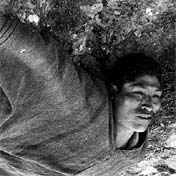 La sangre del condor
|
||
| *** Jorge Sanjinés will give a conference in collaboration with the Comité de solidarité avec le peuple bolivien: Changement social en Bolivie et identité autochtone: témoignage d'un cinéaste engagé *** June 15, 2005 at 8 p.m., salle Claude-Jutra June 16, 2005 at 8:30 p.m, salle Claude-Jutra June 17, 2005 at 6:30 p.m, salle Claude-Jutra June 17, 2005 at 8:30 p.m, salle Claude-Jutra June 18, 2005 at 5 p.m, salle Claude-Jutra June 18, 2005 at 5 p.m, salle Claude-Jutra June 18, 2005 at 9 p.m, salle Claude-Jutra June 18, 2005 at 9 p.m, salle Claude-Jutra |
|||
| PROJECTIONS AT KATERI HALL Tuedsay, June 14 Wednesday, June 15 Thursday, June 16 TRAINING WORKSHOP In the framework of the 2005 First Peoples' Festival, Kanien'kehaka Onkwawen:na Raotitiohkwa and Land InSights offer a Final Cut Pro workshop for intermediate to advanced level filmmakers. This three day workshop taking place in Kahnawake is offered by an Apple certified trainer. You will learn all about the latest features of Apple's cutting edge non-linear editing software. Limited to 10. Sponsored by CentralMac Solutions, KOR, Land InSights, and Apple Canada. The workshop will take place the 20th, 21st and 22nd of June, starting at 9am each day until 3pm. The cost is 150$. Please e-mail us to reserve your place: tev@nativelynx.qc.ca |
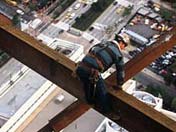 SLAMMI'N IRON |
||





